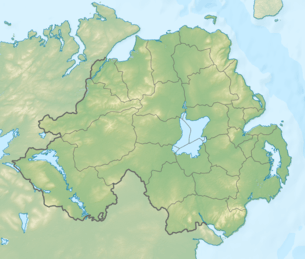Forkhill land mine attack
On the 17 July 1975 the South Armagh Brigade of the Provisional IRA (IRA) detonated a land mine when a British Army foot patrol passed over the land mine, killing four British soldiers and seriously injuring another.[1] This was the first major breach in the truce negotiated by the IRA and British government back in February 1975. The attack took place in Forkhill which was right on the Irish border and a safe haven for IRA Volunteers from South Armagh.[2]
| Forkhill land mine attack | |
|---|---|
| Part of the Troubles | |
 | |
| Date | 17 July 1975 |
Attack type | Roadside bomb Gelignite Explosive material Landmine Attack |
| Weapons | Command Wire Detonation |
| Deaths | 4 British Soldiers |
| Injured | 1 |
| Perpetrator | Provisional IRA South Armagh Brigade |
The attack
On the 17 July 1975 Major Peter Willis, the Green Howards company commander in Crossmaglen was accompanied by three British soldiers, all of whom were bomb disposal experts.[3] They were investigating a milk churn at Cortreasla Bridge in Tullydonnell. They walked through a gap in a hedge which was next to a signpost. As they passed through the hedge an IRA Volunteer pressed a button which sent an electric current through an almost 400-yard long command wire which detonated a bomb which had an estimated between 70 - 80lbs of explosives in a beer keg which was very large for IRA bombs at that stage. All of four soldiers were killed instantly with another soldier injured by shrapnel.[4]
The soldiers killed were Major Peter Willis (37), Edward Garside (34), Robert McCarter (33) and Calvert Brown (25).[5] They were the first British soldiers to die at the hand of the IRA since the February truce.[6]
Aftermath
The IRA claimed in statement that the attack had been in revenge for the killing of two of their own Volunteers. British Secretary of State for Northern Ireland, Merlyn Rees, issued a statement condemning those responsible for the killings.[7]
Evntually an IRA Volunteer called Pat Thompson was convicted of the attack in March 1976 in which Thompson signed a statement saying that the Crossmaglen IRA unit was the unit who planned and carried out the attack. Thompson maintains however that he was forced to sign the statement after bad beatings & threats to his family. Thompson was not released until 1991, serving 15 years.[8]
The next IRA breach of the truce came in August in the Caterham Arms pub bombing in Surrey, England in which 33 people were injured. It was carried out by the notorious Provisional IRA's Balcombe Street Gang.[9]
See also
References
- "Irish Republican History & Remembrance". Retrieved 2019-04-19.
- "CAIN: Chronology of the Conflict 1975". cain.ulster.ac.uk. Retrieved 2019-04-19.
- Toby Harnden - Bandit Country: The IRA & South Armagh pp.58
- Toby Harnden - Bandit Country: The IRA & South Armagh pp.58
- "CAIN: Sutton Index of Deaths". cain.ulster.ac.uk. Retrieved 2019-04-20.
- "4 Soldiers Killed in Ulster by Bomb in a Milk Can". The New York Times. 1975-07-18. ISSN 0362-4331. Retrieved 2019-04-19.
- "4 Soldiers Killed in Ulster by Bomb in a Milk Can". The New York Times. 1975-07-18. ISSN 0362-4331. Retrieved 2019-04-19.
- Toby Harnden - Bandit Country: The IRA & South Armagh pp.58
- "CAIN: Chronology of the Conflict 1975". cain.ulster.ac.uk. Retrieved 2019-04-19.